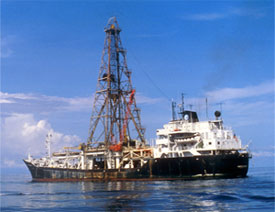INTRODUCTION | RED SEA “HOT BRINES” | METAL-RICH SEDIMENTS | SEAFLOOR ROCKS | OPHIOLITES | “MISSING HEAT”
 |
Metal-Rich
Sediments From 1968 to 1983, the Deep Sea Drilling Project collected sediment cores from around the world using the drilling vessel Glomar Challenger, a 400-feet long ship designed to drill in deepwater. Many of the cores contained metal-rich sediments on top of the volcanic rocks of the ocean crust. (Photo courtesy of the Ocean Drilling Program) |
The Red Sea was exotic, but it wasn’t unique, as it turned out. Scientists spanned the globe in the 1960s, sampling seafloor sediments wherever they could. They found metal-rich seafloor sediments near mid-ocean ridges in the Atlantic, Pacific, and Indian Oceans—wherever the seafloor was spreading apart. The sediments contained high amounts of iron, manganese, nickel, zinc, copper, cobalt, lead, and other metals.
Scientists in the Deep Sea Drilling Project also found similar metal-rich seafloor sediments that had accumulated atop volcanic ocean crust at sites far away from present-day active spreading centers. These ancient deposits had formed at the crest of the mid-ocean ridges and had moved away to their present positions as a result of seafloor spreading. Clearly, there was a connection between metal-rich minerals and volcanic spreading centers.
| Seafloor
Rocks |